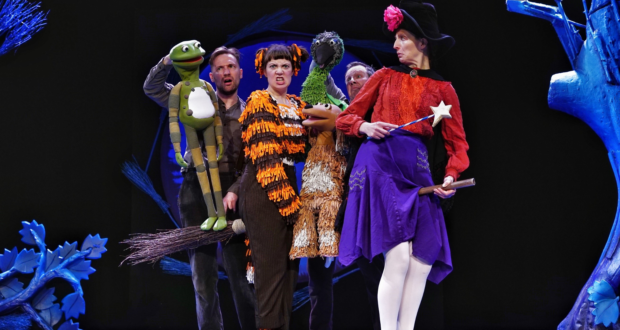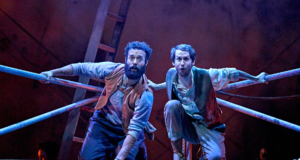Tall Stories’ Olivia Jacobs on producing Room On The Broom
Fans of Julia Donaldson and Axel Scheffler’s fabulous children’s books will be delighted that acclaimed theatre company Tall Stories are bringing their adaptation of Room on the Broom to the West End this summer. We asked company co-founder Olivia Jacobs to land the broom for a minute and magic up a bit of information about the show.
Olivia, Room on the Broom is an absolute favourite picture book for children worldwide; you must feel such a responsibility to adapt it well? How do you go about bringing it to life, from page to stage?
When Room on the Broom was first published, we were hooked immediately, and asked the authors and publishers for the rights. It’s such a brilliant adventure story – with just enough danger, a whole heap of fabulous characters and a hugely positive message about working together. Thankfully both Julia Donaldson and Axel Scheffler had enjoyed our previous stage production of The Gruffalo and felt that there was room on the broom for us!
I was definitely nervous to start work on the show and I still feel that same sense of nervousness and responsibility every time I go into the rehearsal room with a new company. I want to ensure it’s always full of life on stage and that audiences leave the theatre happy and grinning.
It was hard to know where to start developing this beautiful but complex story. We needed to create seven characters: a witch, a cat, a dog, a bird, a frog, a dragon and a mud monster, with a cast of four… We also had the tricky task of flying all of our characters, as well as creating magic spells and appearing a magnificent broom from thin air. No small challenge! We tested ideas in a rehearsal room with some very talented performers and a highly imaginative creative team – which is how we devise all our shows – trying to find the best and most entertaining way to tell the story.
We finally settled on beginning with a camping trip; four campers setting off for a night under the stars. But nothing goes to plan when they see a witch on a broomstick flying down towards them at full pelt…This opening defines the way in which we tell the rest of the story. If audiences watch carefully, there are lots of things in the campsite scene which later find their way into the tale of the witch, the cat and their adventure.
Tell us a bit about the music and puppetry involved.
Puppets have a huge role in this production, and it was so important that we got them right. We had lots of questions to resolve. Which characters would be puppets? What type of puppets should we create? How big should they be? What do they need to be able to do? How many people would operate each puppet? And, of course, what happens when all seven characters are on stage with only four actors – would it be possible to operate more than one puppet at a time? Our puppet designer Yvonne Stone created prototypes for us and we played with these in a rehearsal room to discover exactly what looked best.
Eventually we decided that Dog, Bird and Frog – all the creatures that Witch picks up on her journey – would become puppets in the show, but we determined that the design of Cat’s costume would link her to the puppet animals too.
As the characters emerged in the devising room, the design of the puppets developed too. Bird developed long eyelashes, Frog’s leg length increased, and we finally found a way of operating Dog’s tail so he could wag it as enthusiastically as he wanted to. Whilst the puppeteers make it look easy, the puppetry in the show is really difficult. The actors develop very big muscles!
The music followed logically as the characters became more defined. We wanted a song for everyone who joined Witch and Cat on the broom, so played with ideas of what they might sing about, and why they might want to travel by broom – especially Bird, who has her own wings!
The show is aimed at ages 3+, but do you find older children enjoy it too?
We’ve always tried to make shows that work for all ages. Over 60% of our attendees are grown-ups, so it seems absurd not to try to ensure that all of your audience have fun: the show needs to appeal to everyone. Families come in all shapes and sizes, and we often have older children watching alongside younger siblings. My favourite thing is actually when I hear parents talking afterwards: they often seem surprised to have laughed and had a good time, the expectation being that if it’s for their children it couldn’t possibly also be for them! We hope our shows work on different levels and remain a place where three or even four generations can enjoy being entertained together.
Which is your favourite character in this story?
This is an impossible question to answer. I love Dog’s enthusiasm for life, Bird’s desire to be loved, Frog’s endless charm, Witch’s scattiness and Cat’s ability to succinctly sum up and deal with any situation. And I’m pretty fond of Dragon too, for all his posturing and pretending to be brave – he’s a big softie really. I can’t pick one character – I have a soft spot for them all!
It’s twenty-five years since Tall Stories was founded. Have things changed much since you started, and how did you get through the Covid pandemic in the last couple of years?
When we first started Tall Stories, there were very few companies making work for a family audience, and fewer making cross-generational work. The advent of Harry Potter and Northern Lights (etc) made ‘crossover work’ a genre in itself, with new shows for family audiences springing up countrywide. I hope that we have been even a small part of improving the theatre landscape for family audiences and encouraging others to create great work for this brilliant, imaginative sector.
Tall Stories itself has grown and developed as a company too. Twenty-five years ago it was just my co-founder Toby and I working from a spare room in a small flat in north London; now there’s a team of seven full-time staff based in the Tall Stories Studio in Highbury and Islington.
Of course, the last few years have been hard for everyone in the entertainment industry. Our UK tour of Room on the Broom was cut short, and we rushed actors home from Hong Kong, Australia and America during the pandemic. But audiences have been very supportive and have returned to theatres to provide their children with the opportunity to see high quality performance. It feels very fitting that Room on the Broom, a story about pulling together in times of adversity, is back this year.
Tell us a bit about your charity work, and the Tall Stories Studio.
We’re hugely proud of the new Tall Stories Studio, which opened its doors last year after three years of searching and building. We now have our own beautiful, light, bright, ground floor accessible rehearsal space, with an office, meeting room and costume store all on site. I love that we are based within Islington’s Central Library, surrounded by stories.
From our new home we work closely with the surrounding community, providing free accessible performances of our shows for local families who may not otherwise have access to touring work. As an example, we worked recently with local organisations The Hibiscus Centre, The Parent House and Homestart to welcome single parent families, families who have been victims of domestic abuse and refugees who are new to the community to free performances of The Gruffalo.
Working alongside Islington council, we provide free productions for local school children, who also get to meet and greet the cast after the show and ask any burning questions that they might have.
Within the Studio space we work with, support and nurture new and emerging storytelling artists and companies through our ‘Studio Share’ programme. We offer artists free rehearsal space to develop and share work, as well as opportunities for mentoring sessions with Tall Stories’ professional team.
Outside of the Studio we collaborate with a variety of organisations and schemes, such as The Garden Classroom, with whom we’ve provided a unique drama and forest school experience for children aged 7-11, and Hackney Empire’s ‘Pay It Forward’ scheme which encouraged audiences when booking tickets to purchase extras for families who wouldn’t ordinarily visit the theatre. We continue to be amazed by our audience’s generosity: this year we were able to provide a free trip to Hackney Empire for over 100 under-privileged children and their families.
As a charity, any income Tall Stories receive from our larger scale shows is routed straight back into the company. In this way, we can tour further afield, reach new audiences, offer free performances, accessible performances and develop creative work with young people, families, artists and those who don’t initially see theatre as a possible option for them.
I may be a bit biased, but I think Tall Stories is an amazing company to be part of.
You have a background of touring productions, so how does it feel to be settling in to a West End venue for a big long stretch?
It’s wonderful that we’re flying into the West End for the summer with Room on the Broom and lovely to be working with Nimax and their fabulous team at the gorgeous Lyric Theatre, but we never rest on our laurels. The show will tour the length and breadth of the country between now and April 2023 – visit our website for details about the venues we’re touring to! www.roomonthebroomlive.com
Room on the Broom runs from Thursday 21 July to Sunday 4 September at the Lyric Theatre in Shaftesbury Avenue, London. Further information and bookings can be found here.
 Everything Theatre Reviews, interviews and news for theatre lovers, London and beyond
Everything Theatre Reviews, interviews and news for theatre lovers, London and beyond




